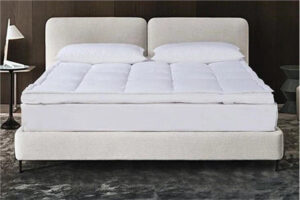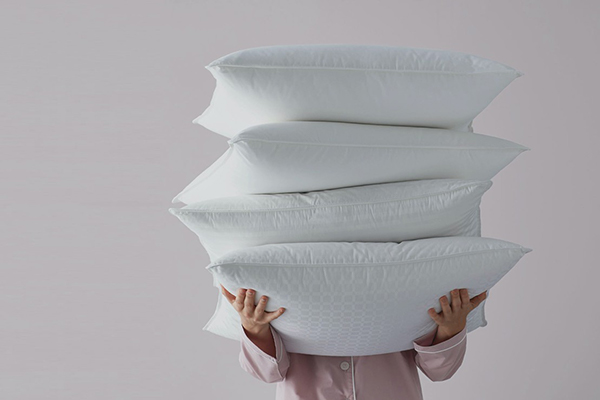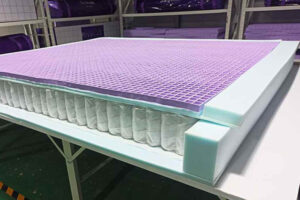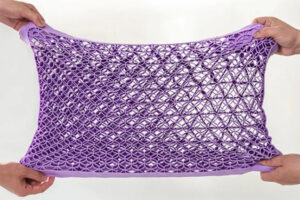Fluffy, white, oblong, soft. Many pillows may look similar, but their support can vary widely. This pillow-buying guide will mention that a good pillow for a back sleeper can be a terrible pillow for a side sleeper. If your pillow doesn’t provide proper support for your head and neck, it can lead to restlessness and tension, which can lead to a poor night’s sleep.
Do your research before buying a pillow to determine which one is right for you to help your mind and body. The information in this pillow-buying guide will help you make the right choice.
1. Before changing the pillow
If you wake up tired and groggy every morning, or find that your sleep is interrupted throughout the night, consider changing your pillow to address your issues and improve your sleep. Pillows can harbor bacteria and dust mites. If you often wake up sneezing, you should change to a new pillow. Try a hypoallergenic pillow and see if your sleep improves.
Some other signs that your pillow needs to be replaced include:
- Stain or discoloration
- Foul smell
- Flatness
Even without these signs, sleep experts recommend changing your pillow every two years to ensure you’re sleeping on a clean, comfortable, allergen-free pillow. Regularly changing your pillow will ensure you get a good night’s rest every night.

2. How to choose a pillow
There are several factors to consider when choosing the right pillow, including your sleep style, allergies, and bed size. The pillow buying guide will give you some considerations. Consider the following things when shopping for a new pillow to optimize your sleep.
1) What position do you sleep in?
You need a pillow that won’t tip your head too much to support your neck and head. If you are a back sleeper, you may need a pillow that is flatter than a side sleeper. People who prefer to sleep on their stomachs should look for a thin pillow so it doesn’t lift the neck too high. You want your spine and neck to be as neutral as possible to reduce stress on both, says Joel Press, MD, chief physical therapist at Hospital for Special Surgery in New York City. If you tend to cycle between sleeping on your back and sleeping on your side throughout the night, choose the firmness of your pillow based on the position you fall asleep in.
2) What type of mattress do you have?
You probably don’t want to ask this question, but it’s important. You want a fuller pillow if you have a firm mattress. If you have a soft mattress, you need thinner pillows. This applies whether you sleep on your side or your back. The reason is that a softer mattress usually allows the body to sink into it, so there is less gap between the head and the mattress. Firmer mattresses prevent you from sinking too deep, leaving a larger gap between the mattress and neck for padding.
3) Are you allergic to certain materials?
Some people may be allergic to latex or buckwheat — both types of fillings that can be found in commercially available pillows. Some people may be allergic to dust mites, which tend to inhabit synthetic pillow fillings like polyester rather than down, according to a study in the International Journal of Occupational and Environmental Medicine. According to the Asthma and Allergy Foundation of America, the use of down and feathers in pillows is regulated, and both are cleaned to ensure they’re free of bird allergens, such as feather dust and mites.
Check the labels of your pillow fillings carefully to make sure there isn’t anything you might be allergic to. There is no federal standard for “hypoallergenic” material, even if a pillow’s packaging or label claims it. Synthetic latex is usually not allergic to. However, it may emit chemicals such as volatile organic compounds or formaldehyde and may harbor dust mites.
If you happen to be allergic to dust mites rather than the pillow material, you might want to consider buying a pillowcase. For example, I have a friend who is an iPhone supplier. Because of his work, he needs to on business all over the world. He stays in hotels on business trips, but because he’s allergic to dust mites. So in case something bad happens, he brings his own pillowcase, bed sheet, and duvet cover every time he travels.
4) Do you sleep hot or cold?
If you tend to sweat easily while sleeping, you need a pillow that breathes and dissipates heat. We found that pillows made of polyester or shredded foam stayed cooler than pillows made of solid foam. And don’t fall for pillows with a “cooling” gel layer: “While they may initially give you a cooling sensation, in the pillows we tested, we found that this feature traps heat and moisture,” says Regan.
5) Do you need an adjustable pillow?
Adjustable pillows are a relatively new concept that allows you to change the filling and customize it to your comfort level — making it less likely that you’ll be unhappy with it anytime soon after you buy it. As a result, they tend to perform better than other pillows in our tests. Manufacturers usually provide a guide with instructions for each sleep method. See our guide on how to customize an adjustable pillow to your liking.
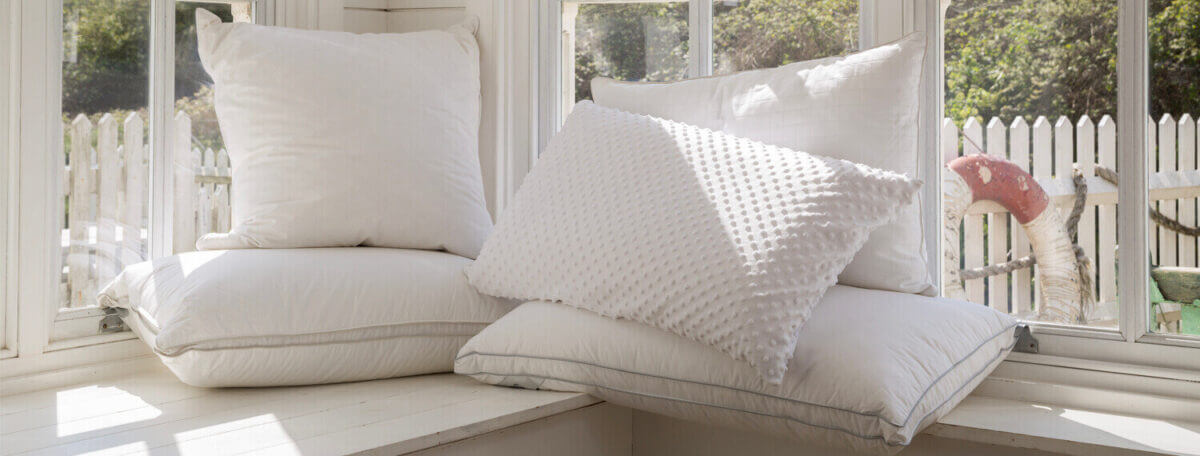
3. Common pillow fillings
This pillow-buying guide provides you with the following common pillow fillers.
1) Latex
Natural latex is made from tree sap. And synthetic latex. Latex pillows can be made from either a single layer or chunks. According to CR’s tests of natural and synthetic latex foams in mattresses, latex responds differently to the body than memory foam — it’s more resilient to the touch and returns to its original shape more quickly after compression.
2) Down or feather
Plush pillows are usually made of goose or duck down. Down is rated for “loft,” which measures the amount of space that one ounce of down takes up. The higher the number, the longer it will stay firm, although usually down pillows will flatten easily. Feather pillows are generally firmer and may not absorb as much heat, but feathers can poke through. Therefore, you need to test the shape retention of the pillow before purchasing.
3) Buckwheat
Buckwheat is a plant-based pillow filler made from small dried seeds. Some people like how well buckwheat pillows fit their heads and neck, but others may find these pillows too noisy (the seeds rustle when you move) or too hard.
4) Water-Filled
These pillows usually have a removable bag that you can fill with water to your preferred firmness. Shells are usually made of cotton or polyester. Some sleepers prefer a pillow that fits snugly to the head. However, some users reported that the water chamber of the pillow was leaking.
5) kapok
Made from the tropical kapok tree, this organic fiber is a silky material that’s softer, lighter, and more vegan than down. Its natural wax coating inhibits moisture absorption, making it ideal for those who sweat during sleep. It also appeals to eco-conscious shoppers, as the kapok filling is harvested from seed pods that fall to the ground – meaning no trees are felled to collect the fibers.
4. Pillow care
Most pillows are machine washable, usually using the cold water setting. But be sure to check the manufacturer’s cleaning specifications on the pillow before washing. Some materials, such as foam board, should not be machine washed.
Unless your pillow is made from a single piece of foam, fluffing it up every day will help it retain its shape. Check the label on the pillow — some manufacturers recommend putting the pillow in the dryer for a few minutes to fluff it as often as you feel the need.
We recommend washing your pillow with hot water once a month (if the manufacturer allows it) to kill dust mites.
5. Tips for purchasing pillows
Whether you go to a store or order online, this pillow-buying guide gives you some advice on what to do when you receive your pillow.
1) Perform a squeeze test
Just because a pillow is labeled “firm” or suitable for side or back sleepers, doesn’t mean it’s the right support for you. Take it a step further and do your own hardness test. If you’re in a store, place the pillow on a flat surface and use the palm of your hand to press it down to about half of its original thickness. The more pressure you apply, the firmer the pillow will be. At home, for the same test, try the pillows on your bed.
2) Loosen it
Pillows that use padding instead of a single piece of foam can deform and cause uncomfortable sleep. So after testing the firmness of your pillow, fluff it up to see if it returns to its original shape and thickness. Make sure the filling is evenly distributed throughout the pillow.
3) Consider its breathability
Most pillows allow air to circulate, but the denser the pillow, the less breathable it is. Those who sleep warm should choose a pillow with a filling that allows air to circulate, such as polyester filling, feathers, or foam blocks.
4) Check the cover
A well-made pillowcase will help extend the life of your pillow. Look for neat stitching, straight seams, and piping to reduce edge fraying. Some pillows have zippers to make it easier to adjust the filling and clean the cover. A tightly woven lid protects the padding.
5) Review the return policy and trial period
Not every pillow manufacturer or retailer offers a return or trial period, but some do.

6. Common questions
This pillow-buying guide provides you with the following frequently asked questions.
1) How to choose the right pillow?
Based on your sleeping style, allergies, bed size, and budget, determine the right pillow material for you. No pillow material or size is right for everyone. Finding a pillow is a very personal process.
2) How firm should a side sleeper’s pillow be?
Side sleepers should look for pillows that are medium firm to firm. Side sleepers need relatively firm pillows that don’t compress when they lie down.
3) Why is my pillow hurting my neck?
If you wake up with neck pain in the middle of the night or when you wake up naturally in the morning, you may need a new pillow. Pillows that are too high or too flat can force your neck to bend unnaturally, which can lead to discomfort.
How useful was this post?
Click on a star to rate it!
Average rating 5 / 5. Vote count: 2
No votes so far! Be the first to rate this post.



